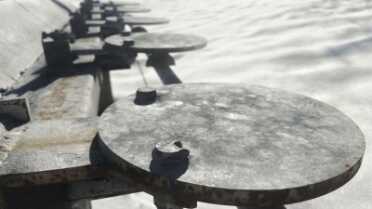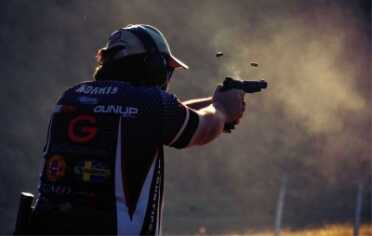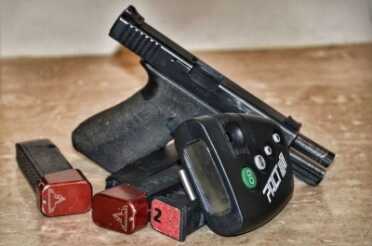
Becky Yackley, the author of the article. She’s no stranger to winning! Follow her 3-Gun adventures on Facebook.
Introduction:
In my first piece in this series, we looked at competitive shooting; why you might want to do it, how to begin, gear and skills we needed, and what discipline we should pick to get our toes wet. The place we landed was Steel Challenge.
The reason this is a good starting point is because Steel Challenge gives you a comfortable, relatively inexpensive, and technically simple place to begin shooting competitions, and learning basic range commands. It’s our “jumping off point” to get into competitive shooting. And for a participant, it’s a great discipline due to the obvious “ping” you hear when you get your hits. It’s like a little music session with your firearms. And for brand new shooters, the feedback you get when you hit the steel is an audible affirmation that you did something right. It’s instantaneous, positive reinforcement.
THE JOURNEY INTO COMPETETIVE SHOOTING
Ep. 1 Getting Started
Ep. 2 Steel Challenge
Ep. 3 USPSA Pistol
Ep. 4 Shotgun
Ep. 5 3 Gun
Ep. 6 High-Power Rifle
Ep. 7 Cowboy Action
Ep. 8 Shotgun II
Ep. 9 IDPA
Ep. 10 Bulls Eye Pistol
Ep. 11 Smallbore Rifle
Andrew and Tim Yackley, pinging steel at the AMU Clinic 2015.
What is Steel Challenge?
Steel Challenge matches are fairly easy to find. There are matches across the country, and they don’t require a huge investment of time and money. You learn the basics, it’s as challenging as you make it, and due to the relatively static type of shooting, it’s much simpler for a person new to competitions to digest.
More specifically, Steel Challenge has a very clear set of rules. There are only eight possible stages, so the rules are well established and consistent wherever you go. The basic stage consists of shooting at four steel plates and one stop plate, for a five-shot string. Each stage consists of shooting the string of fire several times (three out of four, or four out of five), the worst round is thrown out, and the best ones are added together and kept for one’s final score. The goal is to hit each plate before you hit the stop plate, and you can fire as many rounds as you want. You have 30 seconds max to complete each stage. You incur a penalty of 3 seconds for any plates un-hit before you hit the stop plate. If you fail to hit the stop plate, the penalty is 30 seconds. If you hit the stop plate more than one time, your time runs until the last shot fired.
Here is a short introductory video to see what it is you will be doing:
Where Can You Find Steel Challenge?
You know what you want to do, now where do you go? You find a club by letting good ole Mr. Internet work for you. You can start here, at steelchallenge.com.

Steel plate rack. While not in official Steel Challenge matches, outlaw steel matches usually have some version of a plate rack, a Texas Star, or any of a variety of challenging steel targets.

Winner of 2011 Steel Challenge World Speed Shooting Championship, BJ Norris. Combined with his Iron Sight division win in 2012, and previous titles in the Rimfire and Steel- Master divisions, B.J. is the only person in history to have captured every major division title at Steel Challenge.
When you pick a range and a match to attend, make sure to call and confirm the date and time of the event. Often matches are run by volunteers and holidays and weather can affect dates. Call the club or the registration number, tell them you are a new shooter and would like to come out to shoot. Ask if you have to be a member; you might need to obtain special permission to enter a club if it’s private. If you are not in a rush, arrange to attend and watch one night, even if it’s just for a few minutes. If you already shoot and have experience with your gun, ask if you can bring your gear and be put last so you can watch the range commands and shoot at the bottom of the shooter order.
Steel challenge also doesn’t have burdensome requirements for setting targets; someone runs down to spray paint them, they’re hung at a prescribed height, and not on the ground, and it’s much easier for people who aren’t looking for something physically taxing.
Get Ready, Gear Up!
So you know what you want to do, you know where to go, now what do you do to get ready?
Start by reading the rules: https://steelchallenge.com/steel-challenge-Rules-Home.php
Before you grab your gear and ammo and run out the door, check with the club where you plan to shoot. Ask if they have restrictions on what guns you can shoot, for example, some clubs that are not official Steel Challenge matches might not allow rimfire rifle, and some clubs offer “wildcat” divisions. A pistol that meets the division rules for shooting under the United States Practical Shooting Association rules – a standard Glock 17 or 34 would be legal for both USPSA as a Production gun and for Steel Challenge.
Since it’s winter (at the time of writing this) and many clubs move events indoors, you might find a particular caliber is restricted or that you cannot shoot rifles. So call ahead! But basically a Ruger 10/22 works if you plan to shoot the match with a rifle. If you choose to shoot rimfire pistol, you can use a Ruger Mark III .22 pistol and 3 mags. If you watched the video above, you heard that 5 magazines are better, but 3 will do. Use what you have available, and if you can start with a .22, it will save you money and be easier to manage recoil and learn about target transitions.
This video of KC Eusebio — a 4 time Open World Speed Shooting Champion and the youngest to ever win a World Speed Shooting Championship — breaking down transitions will get you going:
Once you have the basic gear: a pistol and several mags, you can begin to dry fire and practice the things you will do in a match. Practice the mechanics so that when you go to shoot, you can consciously focus on target acquisition, and manipulation of the gun isn’t foreign to you. Read about: 180, finger off trigger, etc. I would suggest taking the time to watch some of the famous steel challenge shooters like BJ Norris, Doug Koenig , and other top shooters. This video of Dave Sevigney, Max Michelle, KC Eusebio will show you just how exact and fast the game is.
So practice with dry fire, practice bringing the gun up and onto the target, with your sights aligned (from pointed at the cone if you choose to shoot rimfire division, or from your holster if you plan to shoot another division). Practice moving from one target to another, we call these “transitions.” You want to move your eyes first, and bring the sights over to the target, slowing down ever so slightly as you come onto the target. Your body will move like a tank turret; facing the targets, indexing (think: natural point of aim) off the center of the array, your hips and feet open to allow you to freely transition to the next target. When you move, your body moves with the upper and lower halves, swinging as a unit, rotating from the knees and ankles — you use the force in your legs to quickly move you to the next targets. This is why your weight being on the balls of your feet is important, it puts you at the ready to quickly swing. When you watch experienced shooters, the driving power from the legs in transition is easily identified, notice their eyes and see that the eyes get there first. The video of BJ Norris above has some beautifully crisp transitions.
I practice transitions by dry firing at a window frame, a light switch, and a plate hanging on my wall. I always dry fire facing away from inner rooms or the road. I ALWAYS check that my gun is unloaded, chamber clear, and never have ammo near when I dry fire. If I walked away, or came back to my pistol the next day, I check it again. Never ever work with your guns until you’ve checked that the chamber is empty!
Go: Get moving and do it!
After you get comfortable, go to the range! And take that friend or mentor we talked about in the last article. Grab your gun and ammo, eyes and ears and all the suggested basics from the last article, and pick a match and go shoot.
For those of you who aren’t in the USA to enjoy Steel Challenge, check out international steel matches here: https://www.internationalsteelshoot.com/
About the author: Becky Yackley has been shooting competitively since she began as a teenager with service rifle and smallbore. She’s lived near the typical Marine Corps bases and spent 10 years near DC while her husband was active duty, but has settled into Wisconsin and shooting 3 Gun, USPSA, and Bianchi pistol with her three boys and husband. An avid runner and outdoorswoman, she shoots guns and photos, and sometimes her mouth…which her friends often remind her keeps them “alert” at late hours on road trips. Never known for being quiet, she’s bringing her brand of humor our way this year in hopes of sharing her love for shooting sports with our readers.



my 11 year old grandson shoots a 10/22 with a 4 power scope and a 30 cal m1 carbine with a scope as well as everything else i have. can he use the m1 with FMJ or do you have to use lead tip rounds ? at Tal Al?
Harry,
Some clubs run a Wildcat division, so you would have to talk with the club that you plan to shoot at specifically about the M1…it might fall into a Pistol Caliber Carbine division. As for the 4 power scope on the 10/22, that would be a bit heavy on magnification, since the targets are pretty close – he might get lost in his transitions. Most people shoot a red dot or 1x optic, which gives you a wider field of view. 4x would slow him down.
And to be honest, as a parent with 3 kids shooting well, I will say that a young shooter should start with irons so they understand sight alignment. A dot can help them to work on transition speed and different aspects of shooting, and can be used as a means of “cross training” but having solid foundations in basic principles will help them in whatever firearm they shoot. I’ve met young shooters whose parents have claimed their kid couldn’t do well without a dot – to me that says they don’t have the principles of sight alignment under control. Conversely, letting them shoot a red dot is fun, and younger kids might enjoy it more and not be ready to understand the finer points of sight alignment. So you have to know the youngster and what they can process and use what you have available to it’s best end.
In your list of competitive opportunities you failed to include all of the ISU sports.
Thanks,
David
David, Can you share a link to their web page?
http://www.issf-sports.org/
ISSF disciplines, especially those officially used in the Olympics, are conventional events that overlap Smallbore, Bullseye, and aerial Shotgun already on your list but there are note-worthy differences.
Thanks for the link, and lol, give it time guys – shotgun 1 and shotgun 2, as well as smallbore are pretty general terms…notice that “Steel Challenge” covered more that Steel Challenge.
So far I love this series! When I first started getting into match shooting, it was very hard to find good info on what was going to happen. Hopefully, more people will see these videos and feel confident enough to come out and grow the sport. I’ve been sending the links of these to all my prospective shooting friends. Great job. I also got my 11 yr old into steel matches with his 10/22, he loves it.
Greg, Thank you for sharing with your shooting friends! And good to hear you’re getting your son shooting! My 11 year old loves the 10/22 as well.
Mrs. Becky Yackley I have to say that I think these series of articles are just absolutely fantastic. Very informative, well written, and also very much needed for the firearms community. You do a really great job of getting out there what is needed to get started and what competitions are about. To echo Mr. Coleman’s comments, we need more! Thank you very much!
Chris, Thank you! And yes, we will keep them coming.
A great addition to the series. Looking forward to more! Awesome work Becky.
Thanks for the kinds words Pierce!